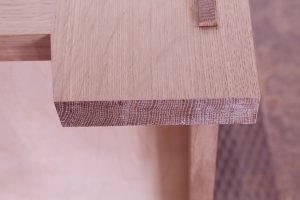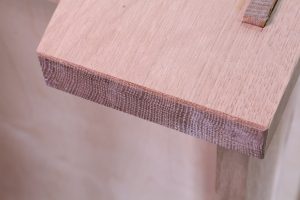We may receive a commission when you use our affiliate links. However, this does not impact our recommendations.
 Working on projects with stump feet is fun. One thing you have to remember is how to handle end-grain feet on a floor. If you just leave them come straight down to the floor, you run the risk of continual tear-out.
Working on projects with stump feet is fun. One thing you have to remember is how to handle end-grain feet on a floor. If you just leave them come straight down to the floor, you run the risk of continual tear-out.
The easiest way to eliminate the problem is to plane a little chamfer around the foot. This ensure the outermost fibers that are rubbing against the floor are being supported by fibers further toward the outside of the board. End grain can be like children, because you’ve taken the time to support them, they’re more likely to stick around. In this case, that almost always a good thing.
Eventually the ends of the feet will wear away to the point where the end grain may start to chip and tear-out again. If it happens in your lifetime, you might want to consider casters.
 Never underestimate the power of a chamfer. It will tame the tear-out and give your pieces a finished look. The old guys seldom did work without a reason and neither should you. Chamfering your stump feet shows you care about your work and stops you from having to do repeated touch-ups as you move your pieces to ever greater places of prominence in your home. Just remember, everything in moderation. Too much of a good thing isn’t good at all. Keep your chamfers small enough not to be noticed but large enough to be effective.
Never underestimate the power of a chamfer. It will tame the tear-out and give your pieces a finished look. The old guys seldom did work without a reason and neither should you. Chamfering your stump feet shows you care about your work and stops you from having to do repeated touch-ups as you move your pieces to ever greater places of prominence in your home. Just remember, everything in moderation. Too much of a good thing isn’t good at all. Keep your chamfers small enough not to be noticed but large enough to be effective.
Here are some supplies and tools we find essential in our everyday work around the shop. We may receive a commission from sales referred by our links; however, we have carefully selected these products for their usefulness and quality.










Oooops I see if I click the blue “chamfer” I am directed toward magical answers by Glen 🙂
Now you’ve opened a can of worms. Block plane? What angle, Rasp, float?? Router?? Brand names……………
Just kidding, but I’m betting somewhere a guy who has never considered a chamfer is wondering. Personally I like a rasp, multi directional tool it is. Every time I try to use a block plane, going across that end grain I blow out a chunklette of face grain at the corners (you can back it up by holding a piece of wood behind the boards edge, but too much like work), and a router is too big and clunky for such a small surface to bear on. I always wonder is my way best, or can I learn something, and that is why I’m throwing it out there.